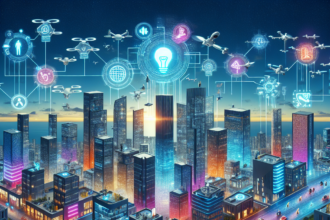Unlocking the Future: How Web3 is Revolutionizing Digital Interactions
In the digital landscape, we have witnessed several transformations, from Web1, characterized by static pages, to the more dynamic Web2, dominated by social media and user-generated content. Now, we stand on the cusp of a new era—Web3— a paradigm shift harnessing the power of decentralization, blockchain technology, and smart contracts. Web3 empowers individuals, enhances digital interactions, and creates a more immersive online experience.
Understanding Web3
Web3 represents a vision for a more democratized internet, where users control their own data, identities, and transactions without reliance on central authorities. Unlike Web2, which focuses on centralization through large platforms like Google and Facebook, Web3 bypasses intermediaries. It enables peer-to-peer transactions and creates a more equitable web, giving individuals ownership of their digital assets.
Decentralization and User Control
At the heart of Web3 is the principle of decentralization. By utilizing blockchain technology, users can interact directly with each other, allowing for greater privacy and security. For instance, instead of entrusting data to tech giants that monetize user information, blockchain-powered applications enable users to maintain ownership and control over their own data. This shift empowers individuals with the ability to access and verify their information securely.
The Role of Smart Contracts
Smart contracts are another fundamental component of Web3, allowing users to establish agreements digitally without intermediaries. These self-executing contracts are coded onto the blockchain, automatically enforcing the terms of an agreement when conditions are met. Smart contracts have the potential to revolutionize industries such as real estate and finance, facilitating secure transactions and reducing the need for traditional legal processes. Imagine buying a house with a smart contract that verifies ownership and transfers funds automatically—this efficiency reduces costs and minimizes fraud.
Enhanced Digital Interactions via NFTs
Non-Fungible Tokens (NFTs) have solidified their position within Web3, enabling unique digital assets to be created, bought, and sold. NFTs represent ownership of digital art, music, videos, and even virtual real estate. Artists and creators can monetize their work directly, eliminating intermediaries that traditionally took a significant cut of profits. This direct engagement creates a stronger community between creators and consumers, revolutionizing how digital interactions occur.
Moreover, NFTs are paving the way for the metaverse—a collective virtual space where users can interact, socialize, and create in immersive environments. As this virtual landscape expands, Web3 not only enhances digital interactions but also creates new opportunities for work, education, and entertainment in virtual settings.
Improved Trust and Transparency
In a Web3 world, transparency is paramount. Blockchain’s immutable nature provides a level of trust that is often lacking in Web2. Each transaction is recorded on a public ledger, allowing all parties to verify processes and ensuring authenticity. This transparency can help build trust in industries plagued by corruption and fraud, such as supply chains and voting systems. For example, consumers can track where products come from, ensuring ethical sourcing, while voting records can be verified for fair and transparent elections.
Challenges and the Road Ahead
While the vision for Web3 is promising, hurdles remain. Issues such as scalability, interoperability, and user adoption must be addressed for widespread acceptance. Education and awareness about blockchain and decentralized technologies are vital in helping users navigate this new digital frontier. Furthermore, regulatory frameworks should be established to protect users while fostering innovation.
As developers and entrepreneurs continue to iterate on these challenges, it is crucial for individuals to remain informed and engaged with these changes. The full potential of Web3 depends on collective involvement, as the foundation is built by the users themselves.
Conclusion
Web3 is poised to revolutionize digital interactions by enhancing user control, promoting transparency, enabling secure transactions, and creating innovative avenues for expression in the digital realm. As we unlock the future of the internet, it is essential to consider the implications, responsibilities, and benefits that come with this transformation. The potential for a decentralized and user-centric digital landscape lies ahead, shaping how we interact with one another in profound and exciting ways.
FAQs
1. What is Web3?
Web3 is the third generation of the internet, focused on decentralization, user empowerment, and blockchain technology. It aims to create an internet where users have control over their own data and online identities.
2. How do smart contracts work?
Smart contracts are self-executing contracts with the terms of the agreement directly written into code on the blockchain. They automate transactions and enforce the conditions when triggered, eliminating the need for intermediaries.
3. What are NFTs?
Non-Fungible Tokens (NFTs) are unique digital assets that represent ownership of a specific item or piece of content on the blockchain. They can be used for art, music, virtual real estate, and more.
4. What are the benefits of decentralization?
Decentralization enhances user control, improves privacy, reduces reliance on third parties, enhances security, and builds trust through transparency in transactions.
5. What challenges does Web3 face?
Some challenges include scalability, interoperability between different blockchains, user adoption, and the need for regulatory frameworks to protect participants while promoting innovation.











